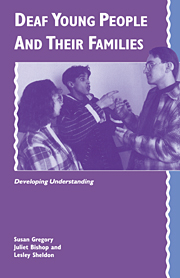Book contents
- Frontmatter
- Contents
- Preface
- Acknowledgements
- 1 The young deaf people and their families
- 2 Family life and communication
- 3 Experiences of education
- 4 The world of work
- 5 Deaf young people in a hearing world
- 6 Friendships, relationships and social life
- 7 Being deaf
- 8 The family and the young deaf person
- 9 Reflections
- References
- Appendices
- Index
8 - The family and the young deaf person
Published online by Cambridge University Press: 26 March 2010
- Frontmatter
- Contents
- Preface
- Acknowledgements
- 1 The young deaf people and their families
- 2 Family life and communication
- 3 Experiences of education
- 4 The world of work
- 5 Deaf young people in a hearing world
- 6 Friendships, relationships and social life
- 7 Being deaf
- 8 The family and the young deaf person
- 9 Reflections
- References
- Appendices
- Index
Summary
Because of the deafness () we've organised things that we'd never have done, we've been to places we'd never have gone to, we've done things we'd never have done.
Mother of Veronica, 21 years, SSEA deaf person alters the lives of everyone in a home; it's a big big disturbance in everything you do.
Mother of Colin, 24 years, BSLFor a hearing family to have a deaf son or daughter has consequences for the private and the public life of the family. Within the family, communication cannot be taken for granted in the way that it is where all the members are hearing or all the members are deaf. This has secondary effects for individual family members and for relationships within the family. Within society, the family becomes a focus of special attention, from doctors, educationalists and other professionals. The family is treated differently and thus can become different. Moreover, society is poorly adapted to meet the needs of deaf people in many ways, including communication and access to information, which creates further issues for the family. In this chapter we address many of the themes developed earlier in the book, but focus on their impact on the family. We start by considering the way in which the young deaf people are perceived by their parents and how this affects the relationship between them. We then look at the effect of deafness on relationships withifr the family and the effect the parents feel it has had on their own lives.
- Type
- Chapter
- Information
- Deaf Young People and their FamiliesDeveloping Understanding, pp. 223 - 253Publisher: Cambridge University PressPrint publication year: 1995



